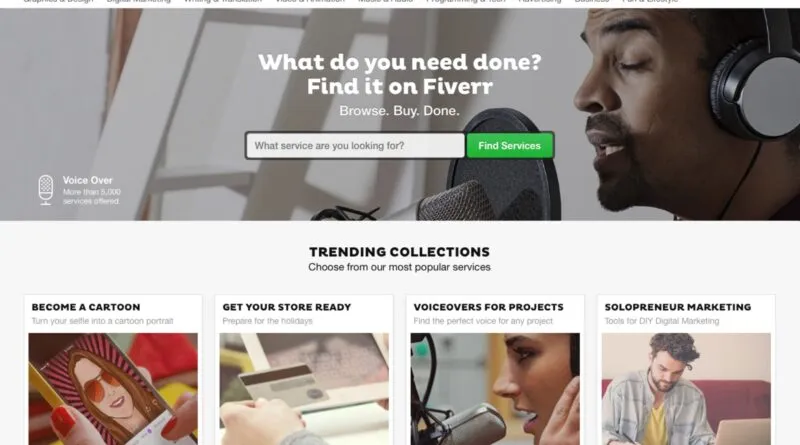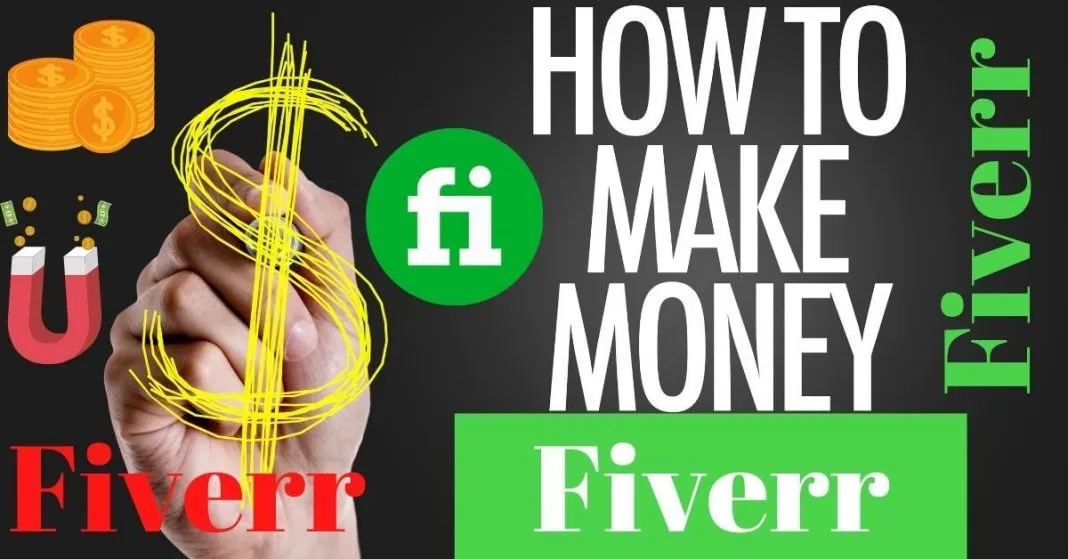Fiverr has revolutionized the way freelancers and entrepreneurs connect, offering a platform where services are available at the click of a button. But have you ever wondered how Fiverr makes money? In this post, we’ll unravel the complexities of Fiverr’s revenue model, exploring the different avenues through which the platform generates income. From service fees to premium memberships, let’s take a deep dive into what makes Fiverr tick.
Understanding Fiverr's Business Model

At its core, Fiverr operates as a marketplace that brings together freelancers (sellers) and clients (buyers) looking for various services. The platform's structure is designed to facilitate this interaction in a seamless and efficient manner, making it accessible to users around the globe.
Here are some critical components of Fiverr's business model:
- Gig Listings: Freelancers create “gigs” to showcase their services. These can range from graphic design to writing and digital marketing. The creativity and uniqueness of each gig attract buyers.
- Service Fees: Fiverr charges sellers a commission on each transaction, typically around 20%. This means if a freelancer charges $100 for a gig, Fiverr takes $20. This commission structure incentivizes both quality and quantity of services offered.
- Buyer Options: Buyers can opt for various service tiers (basic, standard, premium), allowing flexibility and ensuring Fiverr caters to different budgets. Fiverr takes a percentage from each tier as well.
- Fiverr Pro: This premium service allows professional freelancers to offer their skills. Fiverr has stricter vetting processes here, and it charges higher fees, thus increasing revenue.
- Fiverr Business: A tailored service for companies looking to hire freelancers, combining project management and access to a curated pool of talent. It's a subscription-based model, generating steady income.
These aspects highlight how Fiverr not only serves as a hub for freelance services but also employs diverse strategies to maximize its revenue while benefiting users at both ends of the transaction. By maintaining a user-friendly platform and continually adapting to market trends, Fiverr has positioned itself as a leader in the gig economy.
Also Read This: How to Withdraw Fiverr Money Without Payoneer
3. Various Revenue Streams of Fiverr

Fiverr, the online marketplace that connects freelancers with clients, operates on a diverse set of revenue streams. Understanding how Fiverr generates its income can provide valuable insights into its business model and sustainability. Let's explore some of the key revenue streams that Fiverr capitalizes on:
- Service Fees: Fiverr earns a significant portion of its revenue through service fees charged to both buyers and sellers. When a freelancer completes a job, Fiverr takes a cut from the total payment, which usually ranges from 5% to 20% depending on the order's value.
- Subscription Services: Fiverr has introduced subscription models, such as Fiverr Pro, a premium service that connects clients with top-tier freelancers. This model not only attracts high-quality talent but also allows Fiverr to charge a premium for these services.
- Fiverr Business: This is a tailored solution for business teams, providing them with enhanced tools for managing projects and working with freelancers. Fiverr charges companies a subscription fee, which contributes to its overall revenue.
- Advertising Revenue: Fiverr also engages in strategic advertising, both on its platform and through external channels. By promoting certain freelancers or services, Fiverr can generate additional income.
- Affiliate Programs: Fiverr runs an affiliate program that allows marketers to earn commissions by referring new customers. This expands Fiverr's reach while adding another layer to its revenue generation strategy.
These various revenue streams not only diversify Fiverr's income sources but also create a more robust and scalable business model. By leveraging both service fees and innovative subscription offerings, Fiverr continues to thrive in the competitive gig economy.
Also Read This: How to Report on Fiverr: A Comprehensive Guide
4. Service Fees and Commissions

At the heart of Fiverr’s revenue model are service fees and commissions. Whether you’re a buyer looking for a talented freelancer or a seller offering your expertise, understanding these fees can be crucial. So, how exactly do these fees work?
When a transaction occurs on the platform, Fiverr charges a service fee based on the total amount paid by the buyer. This fee structure is typically broken down as follows:
| Order Value | Fiverr Fee (%) | Typical Fee Amount |
|---|---|---|
| Up to $40 | 20% | $8 |
| $40.01 to $199.99 | 15% | $15 |
| $200 and above | 10% | $20+ |
For Buyers: When you hire a freelancer, you’re not just paying for their service; you’re also contributing to Fiverr’s revenue through these service fees. This is how Fiverr ensures that the platform remains operational and can continuously improve the user experience.
For Sellers: Freelancers, on the other hand, need to factor in these commissions when pricing their services. Understanding how much Fiverr takes can help them set competitive rates while still making a decent profit.
In conclusion, the service fees and commissions play a vital role in Fiverr's financial success, ensuring that both freelancers and the platform itself benefit from the transaction, thus fostering a symbiotic relationship within its marketplace.
Also Read This: Can I Mention Fiverr Commercially?
5. Fiverr Pro: Premium Services and Their Impact

Fiverr Pro is a standout feature in the Fiverr ecosystem that elevates the platform's offerings by connecting users with top-tier freelancers. Think of it as the VIP section of the Fiverr marketplace! Here’s how it works:
- Strict Vetting Process: Freelancers who wish to join Fiverr Pro must undergo a rigorous application and approval process. This ensures that only the best in the field, with proven credentials and a professional portfolio, are available.
- Higher Price Points: Since Pro freelancers are considered experts in their niche, they can charge premium prices for their services. This allows Fiverr to generate a more substantial commission on each transaction.
- Quality Assurance: By promoting higher-quality services, Fiverr Pro helps build trust among users. Happy clients mean repeat business and referrals, which is beneficial for the platform.
- Specialized Categories: Fiverr Pro offers services across various categories, including graphic design, writing, marketing, and programming, catering to a wide range of business needs.
The introduction of Fiverr Pro has had a profound impact on the brand's reputation, positioning it as a premier destination for professional freelance work. Moreover, by providing access to elite talent, Fiverr strengthens its appeal to businesses and entrepreneurs who are willing to invest in quality services.
Also Read This: How to Edit Gigs on the Fiverr App
6. Subscription Services and Membership Models
Not content with a single revenue stream, Fiverr has ventured into subscription services and membership models, creating a win-win situation for both freelancers and clients. Here’s the scoop:
| Service | Description | Benefits |
|---|---|---|
| Fiverr Business | A premium subscription designed for teams, offering access to vetted freelancers along with collaboration tools. | - Streamlined hiring process - Increased project efficiency |
| Fiverr Learn | An educational platform that offers courses taught by industry experts, allowing freelancers and clients to sharpen their skills. | - Skill enhancement - Access to exclusive content |
These subscription models allow Fiverr to stabilize its revenue by securing predictable income. For clients, the benefits are clear: they gain access to top-tier services and resources that can help them succeed. For Fiverr, it's not just about earning commissions on individual projects; it’s about fostering long-term relationships with businesses that could lead to consistent revenue streams over time.
Also Read This: How to Hire Multiple Contractors for a Project on Fiverr
7. Advertising and Partnerships
Fiverr has honed its strategy to include various advertising channels and strategic partnerships, driving revenue while expanding its market reach. Let's dive into how these elements contribute to Fiverr's overall financial model.
First off, Fiverr generates revenue through paid advertising. The platform offers promotional options for freelancers looking to gain more visibility. This means that when users search for services, those who are willing to pay for ad placements can have their gigs appear at the top of the search results. This tiered approach gives them a competitive edge and helps Fiverr earn additional fees. Here’s how Fiverr capitalizes on advertising:
- Promoted Gigs: Freelancers pay to showcase their gigs, enhancing visibility in a crowded marketplace.
- Social Media and Google Ads: Fiverr invests in digital marketing strategies, directing traffic to its platform via social media and search engines.
- Content Marketing: By producing valuable content, Fiverr attracts organic traffic, nurturing user engagement.
In terms of partnerships, Fiverr collaborates with various businesses and platforms to enhance its services. These partnerships not only provide additional revenue streams but also enrich user experience. Some examples include:
- Integration with Online Tools: Collaborating with tools like Slack or Shopify enhances Fiverr’s utility for sellers and buyers alike.
- Affiliate Programs: Fiverr's affiliate program enables users to earn commissions by promoting the platform, which further expands its reach.
Through advertising and strategic partnerships, Fiverr diversifies its revenue streams and reinforces its position in the freelancing marketplace. It turns out that sometimes, partnerships really do make a perfect match!
Also Read This: Which Gig is Most Demanded on Fiverr?
8. International Expansion and Its Financial Implications
Fiverr's international expansion strategy has significant financial implications, opening doors to new markets and customer bases across the globe. But how does entering different countries financially benefit Fiverr?
To put it simply, expanding internationally allows Fiverr to tap into diverse economies and demographics. Here are some key financial implications of this expansion:
- Diversified Revenue Streams: By accessing new markets, Fiverr also diversifies its revenue, lessening the impact of economic downturns in any single market.
- Increased User Base: Expanding into countries with burgeoning freelancer communities boosts platform adoption, leading to higher transaction volumes.
- Currency Diversification: Operations in various currencies can act as a hedge against currency risk, stabilizing Fiverr's revenue even in volatile market conditions.
However, international expansion isn't without its challenges. Fiverr must navigate different regulations, tax structures, and competitive environments in each country, impacting its operational costs. To remain profitable, Fiverr may implement several strategic approaches:
| Strategy | Financial Implication |
|---|---|
| Localization of Services | Enhances user experience and increases conversion rates through tailored offerings. |
| Adapting Pricing Models | Flexible pricing can attract more users in different economic conditions, boosting revenue. |
| Targeted Marketing Campaigns | Boosts brand visibility and engagement, leading to higher transaction volumes. |
Overall, Fiverr’s international expansion is a calculated move that paves the way for potential financial growth. As the platform continues to broaden its horizons, we can expect great things in terms of its revenue trajectory!
Also Read This: Why Did I Drop from Fiverr Search After Editing?
9. Challenges and Market Competition
Fiverr has come a long way since its inception in 2010, establishing itself as one of the leading platforms for freelance services. However, navigating the dynamic landscape of the gig economy comes with its own set of challenges and competition that can impact its revenue model.
One of the primary challenges Fiverr faces is market saturation. With countless freelancers offering similar services, it becomes difficult for providers to stand out. This can lead to price wars, where freelancers undercut each other, ultimately diluting the value of their work. When margins are tight, both freelancers and Fiverr can feel the squeeze.
Another significant challenge is the ever-changing competitive landscape. Fiverr isn't the only player in the game—other platforms like Upwork, Freelancer, and more specialized sites are vying for the same freelance talent and client budgets. Each of these platforms has its own unique selling propositions, and Fiverr must continuously innovate to maintain its market share.
Furthermore, user trust and quality control are critical for maintaining a healthy ecosystem. If customers don't have confidence in the quality of services offered, they may turn to competitors. Browsing through thousands of gigs can be overwhelming, leading to potential buyer fatigue. Fiverr must invest in algorithms and tools that make it easier for users to find trusted freelancers, ensuring a seamless user experience.
Lastly, Fiverr faces the challenge of retaining top talent within its community. As more freelancers explore options that might offer better pay or improved terms, Fiverr needs to ensure it remains an attractive platform for high-quality service providers.
10. Conclusion
To sum it up, Fiverr's revenue model is a fascinating blend of innovation and adaptability. The platform effectively leverages a commission-based structure, allowing it to scale while providing value to both freelancers and buyers. However, as we've discussed, it isn't without its challenges.
Competing in a crowded market requires Fiverr to continuously refine its offerings and maintain brand trust. This means constantly monitoring and responding to both market trends and the needs of its users. Yet, this adaptability is also what makes Fiverr a resilient player in the gig economy.
Ultimately, while Fiverr has carved out a significant niche, it must remain vigilant. The freelance landscape is evolving, with new platforms and services appearing regularly. In such a dynamic environment, the ability to pivot and innovate is crucial for long-term success. By focusing on enhancing user experience, investing in quality control, and ensuring fair pricing, Fiverr can continue to be a go-to platform for freelancers and clients alike.



